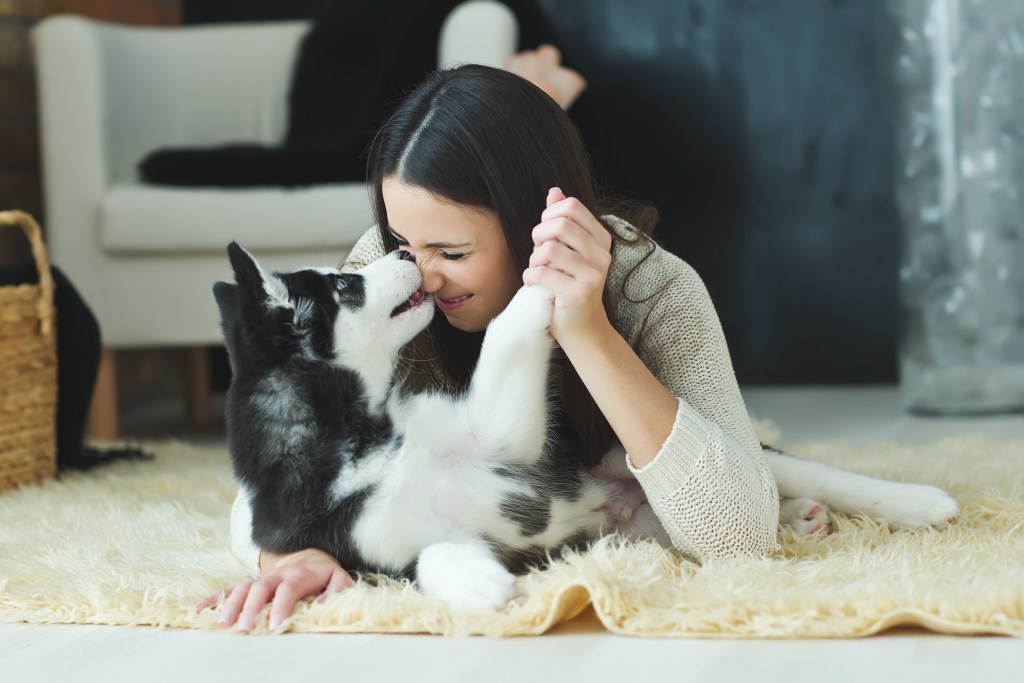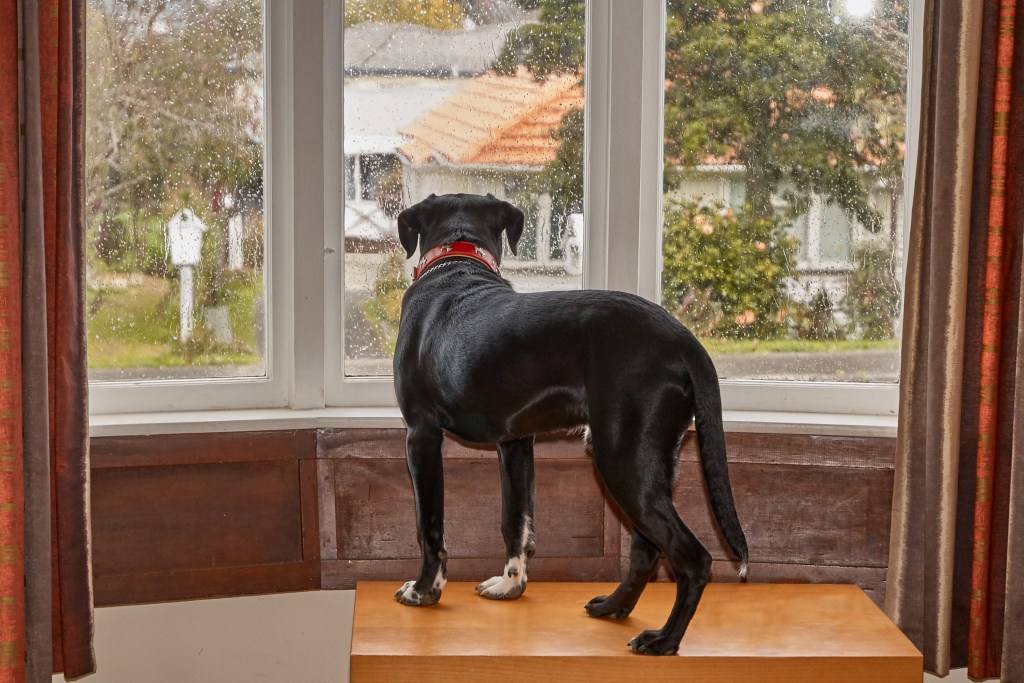During COVID-19, many of us were home all day with our canine companions and developed a routine where we were present in our dog’s lives practically 24 hours per day. Now that people are going back to work and venturing out of their homes more, our dogs are being left home alone and many are experiencing separation anxiety.
“Separation anxiety is normal in dogs, to a degree. After all, they’re social animals that depend on a pack to survive, so they have a natural fear of being left alone,” explains Dr. Joanna Woodnutt, MRCVS, a veterinarian and spokesperson for the Original Calming Bed.
Nicole Rigger, a dog behavioral expert, adds, “Pups that suffer from separation anxiety must be given the opportunity to overcome their anxieties through repeated and elongated challenges to self-soothe. Pups with owners dedicated to training techniques will largely manage their anxiety so that they can be left alone for reasonably long periods of time without harming themselves or their surroundings.”
According to Sara Ochoa, a veterinarian for Doglab.com, “Many dogs wind up suffering from separation anxiety because they are rarely left alone. Many people love to take their dogs with them wherever they go or tend to stay home a lot. This can cause your dog to then develop separation anxiety when they’re forced to stay home alone.”
Other potential causes of separation anxiety occur in these instances:
- When a dog is left alone for the first time (or the first time in a long time)
- When they’re left alone in a crate or kennel for too long
- When the dog is used to being around people and is suddenly left alone
- If the dog has been over-socialized with other dogs and people and then forced to stay on their own
Dogs that are left alone for long periods of time, with a lack of physical and/or mental stimulation, are also prone to develop separation anxiety, which will typically require training and guidance from a veterinarian or dog behavioral expert to overcome. Typically what’s needed is specialized training that will help your dog learn how to settle themselves down and relax when they need to spend time alone.

Separation anxiety symptoms
Separation anxiety typically stems from a dog’s instinct to stay in their pack and follow their pack members. They associate their human family members as members of their pack and someone in your family as their pack leader. When a dog suffers from separation anxiety, it can manifest itself in multiple ways.
Some of the common symptoms your dog might exhibit include:
- Accidents in your home when they’re already potty trained
- Acting restless
- Anxious chewing or scratching
- Chewing or excessively licking their paws (or tail)
- Destructive behavior
- Digging or scratching on furniture
- Excessive lip licking
- Howling or crying
- Pacing or circling (i.e., they’re not able to settle down)
- Panic or trembling behavior
- The dog throws itself at the door repeatedly
- Trying to escape their kennel
- Vomiting or diarrhea
If your dog is showcasing some combination of these behaviors, seriously consider speaking with your veterinarian or an animal behavioral expert to confirm separation anxiety and not some other medical issue is the cause.
While you may see the impact of destructive behavior when you return home, to determine if your dog is experiencing these other symptoms while your away, consider installing a “puppy cam” camera in your home. Many of these cameras connect via the internet with your smartphone and allow you to see live video feeds (with sound) from wherever you are, as long as your smartphone has a cellular data or a WiFi internet connection. Some of these cameras also record your dog’s behavior, which can be useful to share with your veterinarian or a dog behavioral expert.
Three relatively low-cost “puppy cams” include the Furbo Dog Camera ($118.00), the NEST Cam Indoors ($99.99), and the WOpet TitBit Interactive Dog Camera ($129.99).
Once an expert diagnoses separation anxiety, work with a professional to develop a plan for helping your dog overcome their unique set of symptoms through a combination of training, adjusting your behavior (as the human), medication, and/or various over-the-counter products. It’s important to understand, however, there are no instantaneous solutions.

Treatments for separation anxiety
Treating a dog to overcome separation anxiety takes time and a plan. It should start with the pet parent creating a comfortable place for the dog to be, where they feel safe, whenever they’re left alone.
Next, try leaving your dog alone for just five minutes at a time, and then over a period of weeks or months, based on the advice of an expert, increase the amount of time they’re left alone to several hours. “Once your dog has successfully stayed at home for longer than four hours, they can usually make it all day without having anxiety,” Dr. Ochoa says.
Whenever you need to leave your dog, refrain from making a big deal out of your departure. Be as nonchalant about it as possible. This is also true when you return home. Your coming and going should be perceived as a normal occurrence.
Dr. Woodnutt agrees: “Preventing separation anxiety in puppies is much easier than treating it. Make sure that young puppies are exposed to being left alone for short periods of time, and then gradually longer periods of time. They should be given positive distractions, like treats. Before leaving them, ensure they are recently toileted, so they’re relaxed. Making sure they have a safe space to retreat to, such as a favorite bed and/or a crate, is a good bet. Never make a fuss before you leave or as you return. Instead, act like it’s totally normal and that there is nothing to worry about.”
Before giving your dog prescription medications from a veterinarian to treat separation anxiety, consider trying over-the-counter dog food and supplements that are designed to help a dog stay calm.
Dr. Linda Simon, a veterinary surgeon and consultant for FiveBarks, explains, “There are prescription diets and supplements that can help. For example, Royal Canin makes a calming dry kibble that is rich in L-Tryptophan, a serotonin precursor, which enhances mood.”
Travis Rice, Founder of WOOOF Nutrition, states, “The key thing owners need to know about calming supplements is that they are not sedatives. Don’t expect to give your dog a few soft chews and see results in one day. A good supplement will contain ingredients, like chamomile, passionflower, GABA, I-tryptophan, melatonin, lemon balm, and/or ashwagandha, along with other natural ingredients that do a great job helping bring down stress levels, anxiety, and destructive behavior.”
An at-home treatment program for separation anxiety, called Canine Separation Anxiety Cure (CSAC), was developed by Dog Savvy Los Angeles and Alexandra Bassett, a certified dog trainer and behavior expert. This six-week program, which is available online in the form of one-on-one live video call training, along with a printed program guide and workbook, advocates for adopting a training and holistic approach to helping a dog overcome their anxiety. Local dog behavioral experts in your area may offer a less-costly, in-person training option.

Final thoughts…
If left unaddressed, a dog that suffers from separation anxiety will likely develop worsening symptoms. “When a dog does not feel secure or content to be left alone, this takes a lot out of them. We are likely to see bad behavior escalate due to high stress levels, even when they’re not left alone. This will be a strain on their relationship with the people in their life,” Dr. Simons says.
Once you discover your dog may be suffering from separation anxiety, consider adopting a three-pronged approach, which includes nutraceuticals (a special diet or supplements), behavioral modification therapy and training by an experienced professional, and for extreme cases, the use of prescription medication (such as Fluoxetine, which is commonly referred to as doggy Prozac).
On an ongoing basis, as a pet parent, you can help prevent separation anxiety from developing, starting when your dog is still a puppy, using training, maintaining a routine, giving them positive experiences, and by taking steps to ensure your dog’s physical and mental health.
“If you notice that your dog is having a difficult time adjusting to a new schedule or routine, talk with your veterinarian about treatment options. It’s important to address your pet’s separation anxiety and other signs of mental health issues early to both relieve their suffering and keep the symptoms from progressing,” says Dr. Sharon Campbell, DVM, MS, DACIM, the Medical Lead & Behavior expert at Zoetis Petcare.



